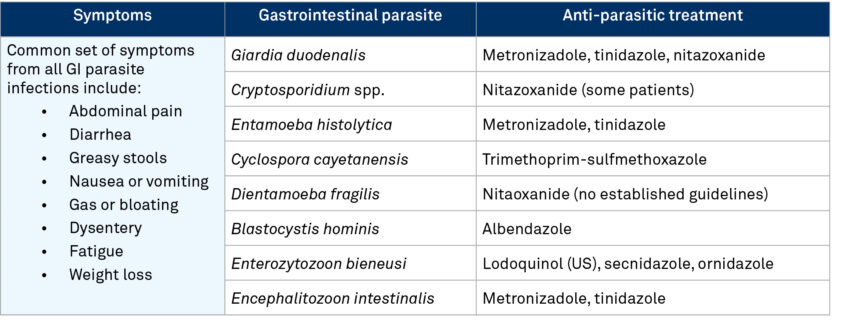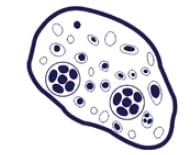Dientamoeba fragilis: symptoms, prevention and treatment

Symptoms of Dientamoeba fragilis infection
D. fragilis transmission is most likely to occur via the fecal-oral route, such as from swallowing contaminated food/water or touching an object contaminated with feces containing D. fragilis.
When infected, D. fragilis does not always result in symptomatic infection, though symptoms when present, are typical of gastrointestinal pathogens with clinical manifestations including;
- Abdominal pain
- Weight loss
- Nausea
- Flatulence
- Diarrhea and altered bowel movements[1].
These symptoms are often in association with eosinophilia, which is reported in up to 50% of patients [1-4).
D. fragilis has been reported in association with colitis in some cases [2,3].
The benefits of employing molecular syndromic testing for overlapping gastrointestinal signs and symptoms
Genetic Signatures' EasyScreen Gastrointestinal Parasite Detection Kit can detect 8 parasite pathogens from a single sample, in a single test, increasing the likelihood of identifying co-infections from multiple parasites that might be missed with traditional testing methods. This is particularly important in cases where patients present with non-specific or overlapping symptoms that could be caused by a variety of gastrointestinal pathogens.
Preventing D. fragilis infection
To prevent the spread of infection, it is important to practice good hand hygiene, especially after using the toilet and before handling food.
Measures that can be followed include:
- Wash hands thoroughly using soap and dry them with a clean towel after using the toilet, before preparing or eating food and after handling nappies
- When travelling in countries where the water supply may be unsafe, avoid drinking unboiled tap water
- Do not eat food or drink water that may be contaminated by sewage.
Wash all raw vegetables and fruits before eating - Isolate from childcare, school, work and water activities for at least 24 hours after symptoms of diarrhea have stopped
- If working as a food handler, the exclusion period should be until there has been no diarrhea or vomiting for 48 hours
- Educate everyone on the importance of washing hands to prevent infection



Treatment for D. fragilis infection
Many studies have shown that treatment of D. fragilis with antimicrobial agents can relieve clinical symptoms, though there is no consensus on what this treatment should be. The most common antimicrobials used to treat D. fragilis include iodoquinol, metronidazole, tetracycline, paramomycin, newer nitromidazoles derivatives have also been used in combination therapy [4].
Treatment challenge:
Treatment of gastrointestinal parasite infections is challenging due to parasite diversity and their specific treatment requirements, despite causing common symptoms (see table below). Misdiagnosis can lead to ineffective treatment. In addition, misuse or overuse of anti-parasitic drugs can lead to the development of antimicrobial resistance. Thus, timely and accurate detection of parasitic pathogens can support appropriate patient management and improve health outcomes.

Syndromic testing for 8 gastrointestinal parasites in a single test
Up to 60 patients screened in a single, automated workflow...with same day reporting!

Find out more about our unique 3base™ solution for detecting gastrointestinal parasites
References
- Stark D, Barratt J, Chan D, Ellis JT. Dientamoeba fragilis, the Neglected Trichomonad of the Human Bowel. Clin Microbiol Rev. 2016 Jul;29(3):553-80. doi: 10.1128/CMR.00076-15. PMID: 27170141; PMCID: PMC4861990.
- Vandenberg O, Peek R, Souayah H, Dediste A, Buset M, et al. (2006) Clinical and microbiological features of dientamoebiasis in patients suspected of suffering from a parasitic gastrointestinal illness: a comparison of Dientamoeba fragilis and Giardia lamblia infections. Int J Infect Dis 10: 255–261. PMID: 16469517
- Cuffari C, Oligny L, Seidman EG. 1998. Dientamoeba fragilis masquerading as allergic colitis. J Pediatr Gastroenterol Nutr 26 :16 –20. http://dx .doi.org/10.1097/00005176-199801000-00003.
- SheinR, Gelb A. 1983. Colitis due to Dientamoeba fragilis. Am J Gastroenterol 78:634 – 636.
- Stark D, Barratt J, Chan D, Ellis JT. Dientamoeba fragilis, the Neglected Trichomonad of the Human Bowel. Clin Microbiol Rev. 2016 Jul;29(3):553-80. doi: 10.1128/CMR.00076-15. PMID: 27170141; PMCID: PMC4861990







